Pea Ridge NMP Tour Stop #9
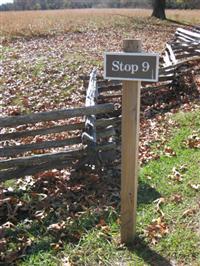 Directions: Now return to your car and drive about a half a mile to the Park's Tour Stop #9 along the Park's Tour Road. Their will be a parking area [ Waypoint = N36 26.963 W94 01.316 ] on the left (east) side of the road next to Ruddick's Field. After reading the interpretive sign, walk about 50 feet from the tour road along the northern edge of the field.
Directions: Now return to your car and drive about a half a mile to the Park's Tour Stop #9 along the Park's Tour Road. Their will be a parking area [ Waypoint = N36 26.963 W94 01.316 ] on the left (east) side of the road next to Ruddick's Field. After reading the interpretive sign, walk about 50 feet from the tour road along the northern edge of the field.
“Confederate Sunset” Interpretive Sign [ Waypoint = N36 26.967 W94 01.308 ] text reads as follows:
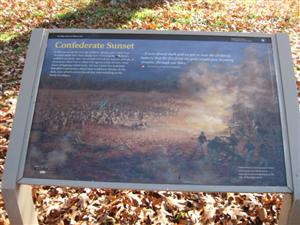 “As the sun set on the first day of battle, about 3,000 rebels from Missouri made their final charge here. Crossing Ben Ruddick's stubbled cornfield, they ran straight toward the muzzles of Federal cannon set wheel hub to wheel hub against a line of trees. After hours of fighting withdrawals, this last Union line held firm. Rebuffed Confederates ebbed back to Elkhorn Tavern. In the dusk, men of both armies feared they were standing on the brink of collapse.”
“As the sun set on the first day of battle, about 3,000 rebels from Missouri made their final charge here. Crossing Ben Ruddick's stubbled cornfield, they ran straight toward the muzzles of Federal cannon set wheel hub to wheel hub against a line of trees. After hours of fighting withdrawals, this last Union line held firm. Rebuffed Confederates ebbed back to Elkhorn Tavern. In the dusk, men of both armies feared they were standing on the brink of collapse.”
“ '...it was almost dark and we got so near the [Federal] battery that the fire from the guns would pass in jetting streams, through our lines.' – Asa Payne, private, 3rd Missouri Regiment”
“Outnumbered, hard-pressed Union cannoneers and infantrymen regrouped and reloaded here at the edge of Ruddick's Field.”
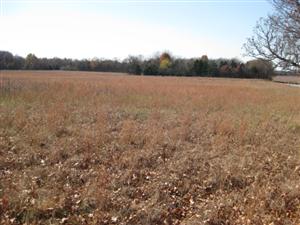 Description: At the northern edge of Ruddick's Field, you are standing near the southern most approach by the Confederates fighting in the late afternoon on March 7th. You are standing near the location of Tull's Missouri Battery [ Waypoint = N36 26.968 W94 01.284 ]. Walk another 100 yards east along the fence line and turn to face south. The Federals had set up another line of defense 200 to 300 yards away along the southern edge of Ruddick's Field. Major General Sterling Price struggled to organize an attack across the field, as the Confederates had become disorganized after forcing the Federal withdrawal from Elkhorn Tavern.
Description: At the northern edge of Ruddick's Field, you are standing near the southern most approach by the Confederates fighting in the late afternoon on March 7th. You are standing near the location of Tull's Missouri Battery [ Waypoint = N36 26.968 W94 01.284 ]. Walk another 100 yards east along the fence line and turn to face south. The Federals had set up another line of defense 200 to 300 yards away along the southern edge of Ruddick's Field. Major General Sterling Price struggled to organize an attack across the field, as the Confederates had become disorganized after forcing the Federal withdrawal from Elkhorn Tavern.
Walk across the field to the gun carriages marking the location of the Federal line of battle at Ruddick's Field [ Waypoint = N36 26.886 W94 01.365]. You may find it easier, if longer, to walk back to the tour road, down to the southern end of the field, and then over to the gun carriages. Now you are standing on the Federal line of battle. Look to the north towards the timber line.
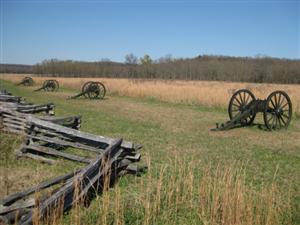

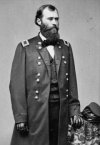 Union Colonel Eugene Carr, although wounded several times during the fighting, established the Federal's next line of defense by deploying Vandever's and Dodge's brigades along the southern edge of Ruddick's Field. Vandever was on the left and Dodge was on the right. Carr also was able to bring together thirteen artillery pieces and deploy them at the southern edge of Ruddick's field. In the late afternoon on March 7th, Price sent his Confederates across Ruddick's Field, but the Federals “poured so hot a fire into [the Confederate] ranks that they fled in confusion.”
Union Colonel Eugene Carr, although wounded several times during the fighting, established the Federal's next line of defense by deploying Vandever's and Dodge's brigades along the southern edge of Ruddick's Field. Vandever was on the left and Dodge was on the right. Carr also was able to bring together thirteen artillery pieces and deploy them at the southern edge of Ruddick's field. In the late afternoon on March 7th, Price sent his Confederates across Ruddick's Field, but the Federals “poured so hot a fire into [the Confederate] ranks that they fled in confusion.”
Just before dark Union Commander Samuel R. Curtis arrived with about 500 reinforcements and ordered a counterattack against the Confederates in the woods north of Ruddick's Field. The counterattack did not succeed and the Federals withdrew back to the southern edge of Ruddick's Field.
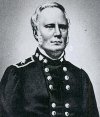 Southern General Sterling Price wrote of these events in his official report:
Southern General Sterling Price wrote of these events in his official report:
“I now advanced my whole line, which gradually closed upon the enemy and drove them from one position to another, until we found them towards evening in great force on the south and west of an open field, supported by masked batteries. The artillery and infantry of my left wing were brought up to attack them, and they did so with a spirit and determination worthy of all praise. The fiercest struggle of the day now ensued; but the impetuosity of my troops was irresistible, and the enemy was driven back and completely routed. My right had engaged the enemy's center at the same time with equal daring and equal success, and had already driven them from their position at Elkhorn Tavern. Night alone prevented us from achieving a complete victory.
“My troops bivouacked upon the ground which they had so nobly won almost exhausted and without food, but fearlessly and anxiously awaiting the renewal of the battle in the morning.”
Price had lost two of his commanders on this day. Brigadier General William Y. Slack, commanding the 2nd Missouri Brigade, had been mortally wounded in the fighting. Lieutenant Colonel James T. Cearnal, commanding the Missouri Cavalry Battalion, had been severely wounded.
 Directions: Now return to your car and drive about a half a mile to the Park's Tour Stop #9 along the Park's Tour Road. Their will be a parking area [ Waypoint = N36 26.963 W94 01.316 ] on the left (east) side of the road next to Ruddick's Field. After reading the interpretive sign, walk about 50 feet from the tour road along the northern edge of the field.
Directions: Now return to your car and drive about a half a mile to the Park's Tour Stop #9 along the Park's Tour Road. Their will be a parking area [ Waypoint = N36 26.963 W94 01.316 ] on the left (east) side of the road next to Ruddick's Field. After reading the interpretive sign, walk about 50 feet from the tour road along the northern edge of the field. “As the sun set on the first day of battle, about 3,000 rebels from Missouri made their final charge here. Crossing Ben Ruddick's stubbled cornfield, they ran straight toward the muzzles of Federal cannon set wheel hub to wheel hub against a line of trees. After hours of fighting withdrawals, this last Union line held firm. Rebuffed Confederates ebbed back to Elkhorn Tavern. In the dusk, men of both armies feared they were standing on the brink of collapse.”
“As the sun set on the first day of battle, about 3,000 rebels from Missouri made their final charge here. Crossing Ben Ruddick's stubbled cornfield, they ran straight toward the muzzles of Federal cannon set wheel hub to wheel hub against a line of trees. After hours of fighting withdrawals, this last Union line held firm. Rebuffed Confederates ebbed back to Elkhorn Tavern. In the dusk, men of both armies feared they were standing on the brink of collapse.” Description: At the northern edge of Ruddick's Field, you are standing near the southern most approach by the Confederates fighting in the late afternoon on March 7th. You are standing near the location of Tull's Missouri Battery [ Waypoint = N36 26.968 W94 01.284 ]. Walk another 100 yards east along the fence line and turn to face south. The Federals had set up another line of defense 200 to 300 yards away along the southern edge of Ruddick's Field. Major General
Description: At the northern edge of Ruddick's Field, you are standing near the southern most approach by the Confederates fighting in the late afternoon on March 7th. You are standing near the location of Tull's Missouri Battery [ Waypoint = N36 26.968 W94 01.284 ]. Walk another 100 yards east along the fence line and turn to face south. The Federals had set up another line of defense 200 to 300 yards away along the southern edge of Ruddick's Field. Major General 

 Union Colonel Eugene Carr, although wounded several times during the fighting, established the Federal's next line of defense by deploying Vandever's and Dodge's brigades along the southern edge of Ruddick's Field. Vandever was on the left and Dodge was on the right. Carr also was able to bring together thirteen artillery pieces and deploy them at the southern edge of Ruddick's field. In the late afternoon on March 7th, Price sent his Confederates across Ruddick's Field, but the Federals “poured so hot a fire into [the Confederate] ranks that they fled in confusion.”
Union Colonel Eugene Carr, although wounded several times during the fighting, established the Federal's next line of defense by deploying Vandever's and Dodge's brigades along the southern edge of Ruddick's Field. Vandever was on the left and Dodge was on the right. Carr also was able to bring together thirteen artillery pieces and deploy them at the southern edge of Ruddick's field. In the late afternoon on March 7th, Price sent his Confederates across Ruddick's Field, but the Federals “poured so hot a fire into [the Confederate] ranks that they fled in confusion.” Southern General
Southern General